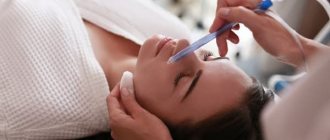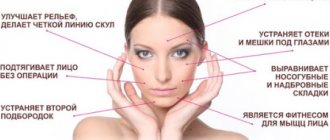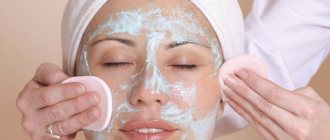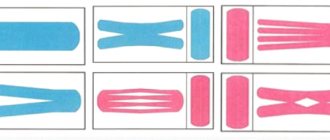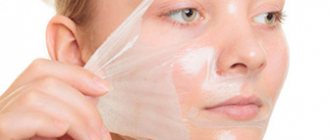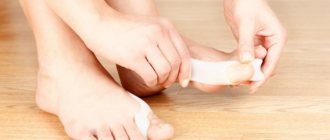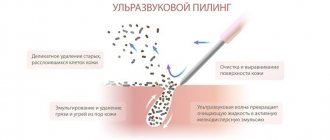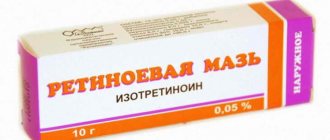Peeling involves peeling. These two words are essentially identical in meaning. It is intensive exfoliation followed by skin restoration that is the key goal of peeling. However, it often happens that the procedure is completed, but peeling does not occur at all. Could this be the norm? Or should I demand my money back from the cosmetologist? Let's figure it out.
The skin after peeling does not always peel off.
The process of natural exfoliation always occurs in the epidermis. The skin is renewed, cells die off and in most cases they are removed during showering, washing or using homemade scrubs. Any peeling, one way or another, is aimed at powerfully accelerating this process. After intense peeling, you will see a renewed, fresh, rejuvenated face. This is why a lot of questions arise if the skin does not peel off after peeling. This can happen for several reasons.
You have chosen a gentle peeling
Or rather, a gentle peeling has been chosen for you if you are carrying out the procedure in a salon. Let us explain why this happens.
Aesthetic medicine, which tries to make a woman young and beautiful regardless of age, does not have standard solutions or universal recipes. The specialist (if he is a professional) will definitely take into account all the individual characteristics of the client.
The first visit to the salon for chemical facial cleansing always involves a gentle procedure. This is why there is no peeling after peeling.
The second position - products based on glycolic and fruit acids were used. Such procedures are classified as superficial; they do not affect the deep layers of the epidermis (and even more so do not affect the dermal tissues). The peeling of dead cells can be so slight that it is simply not visible to the naked eye.
The third position is a modern modified exfoliant. The products are designed in such a way that they do not have an aggressive effect on the skin, but remain no less effective. Therefore, there will be no peeling.
Incorrect concentration
Many types of peelings can be both superficial and medium. It all depends on the following parameters:
- active ingredient concentration;
- exposure (actual time the drug remains on the skin);
- the number of layers of the drug and the degree of its rubbing (if required by the protocol).
An experienced cosmetologist always varies these indicators in order to achieve their goals. It focuses on the condition of your skin, your medical history, previous procedures, as well as your reaction during the session. Sometimes even light formulations cause such severe burning and redness that the specialist reduces the exposure and the number of layers. That's why in many cases a cosmetologist can do too light a peeling, from which you will not get either peeling or the desired effect. This is especially true when working with new clients. This outcome cannot be considered a mistake; it’s just necessary to increase the peeling effects next time.
Peeling has already passed
The absence of unpleasant dry flakes, which scare women the most, is possible not only when performing facial peeling with a gentle composition for the first time.
Women who regularly take care of their appearance and carry out cosmetic procedures in a salon or at home achieve amazing results. That is, the keratinized skin particles are so small, and the epidermis itself is pliable and susceptible to influence, that the upper dead layer is removed when the working composition is removed. Consequently, during the post-peeling period, skin peeling is not observed at all, or is very mild.
The time for peeling has not yet come
The skin after peeling does not begin to peel off “this very second and now.” A certain amount of time must pass before this process begins. As a rule – 2-3 days.
At first, the face becomes a darker shade, then the upper ball begins to crack slightly and the keratinized particles begin to separate with varying degrees of intensity. This depends on several factors:
- depth of influence. Superficial peeling will not cause a particularly strong reaction and only slight peeling will be noticeable. The middle version of the impact involves the detachment of significant flaps of skin. The pieces look like dry, thin parchment. Under no circumstances should they be forcibly removed or scrubs used for these purposes. Deep peeling is a procedure performed only in a hospital setting and the rehabilitation period is characterized by very severe peeling, reminiscent of “molting”;
- exfoliant used. We have already mentioned this factor. The more aggressive the agent, the more pronounced the process will be;
- pronounced hyperkeratosis or the first procedure in many years. In this case, peeling will not happen, since your skin needs more extensive intervention to remove a sufficiently large number of dead scales that have accumulated over previous years or due to the individual characteristics of the epidermis.
Let us especially dwell on the fourth factor.
Kinds
Depending on the type of skin, existing problems, and the required depth of exposure, cosmetologists can use one of four types of Jessner peeling.
Super-superficial
In this case, low concentration drugs are used. These may be enzymes or agents. This procedure has a softening effect and, without injuring the skin, removes keratinized particles from the surface of the epidermis.
Surface
It implies a minor burn, as a result of which even the granular layers of the epidermis are damaged. With this technique, the effect is as follows - the pores are narrowed, the complexion is evened out, brightened and takes on a healthy appearance. This type of technique can be done not only with fruit acid, but also with mandelic and succinic acid.
Median
As a result of such peeling, the skin receives a 2nd degree burn. This manipulation is accompanied by a long rehabilitation period and high-quality skin care.
With the Jessner medium peel, the dermal layers are also exposed. As the epidermis recovers, it takes on a fresh appearance, facial wrinkles are almost completely smoothed out and become almost invisible.
Freckles, pigmentation, and flat warts disappear.
Deep
The recovery period in some cases can reach up to 30 days. The skin receives a severe, deep third-degree burn. Proper care after the procedure is a prerequisite, which promotes rapid healing of the epidermis and prevents the development of side effects.
After the skin is restored, there is an evenening of color and tone, the disappearance of shallow wrinkles, and an increase in firmness and elasticity. The contours of the oval face become more toned.
You have a special skin type
There is such a thing as “resistant epidermis”. People with this skin type are naturally resistant to damage. The face does not blush, and during the procedure of chemical cleansing and rejuvenation there are no uncomfortable sensations in the form of burning or tingling. These lucky ones are not prone to allergic manifestations.
In this case, it is very difficult to “exfoliate your face” with peeling. Unless it's deep. However, we cannot talk about the uselessness of cosmetic procedures. It’s just that the reaction to exposure by workers is somewhat different from the usual.
Release form
The drug Bepanten is available in the form of ointment, cream and lotion. In addition to the main components, the manufacturer adds ingredients that give each of these compositions their characteristic properties.
Thus, excipients directly affect the viscosity, ease of application, distribution and absorption rate of the composition.
Thanks to such variations in composition, manufacturers are making topical medicine available to more people.
So, for some people it will be safer to use the medicine in the form of a cream. While others will find lotion more useful and effective. To achieve intensive therapy, you can use Bepanten plus cream.
What will cosmetologists say?
Experts say that those with oily skin types most often report a lack of peeling after chemical peeling. The reason is simple - the sebaceous secretion binds the keratinized particles and they either “fly off” during the removal of the composition, or a more thorough cleansing is required with a repeat procedure at least two weeks later.
After yellow peeling, there is no peeling in people with special skin types (we have already talked about them). Also, a similar reaction can be observed if the treatment is not retinoic (using retinoic acid), but retinol (using vitamin A and its natural derivatives). The second option is softer, more gentle, providing only a superficial effect on the epidermis. But it is less effective.
Salicylic peels may also not cause peeling in people with oily skin or low acid concentrations. Although this type of procedure is considered a very good preparation before more aggressive influences. Salicylic acid in the composition of the product very well loosens the upper stratum corneum. However, the manipulation needs to be done a week and a half before the “heavy artillery”.
Detachment of epithelial cells occurs imperceptibly when using the “correct” cosmetic products in the post-peeling period and following post-care rules.
Even if the skin does not peel off, cosmetologists advise:
- wash your face after chemical exfoliation with any composition the next morning. For these purposes, it is recommended to use cleansers with a neutral pH (not soap! – it dries). Thermal water or regular mineral water without gas will do;
- Do not use decorative cosmetics for 3-4 days. The effect of peeling will be more pronounced;
- during the entire rehabilitation period (the full recovery cycle ranges from 7 to 14 days) do not use scrubs, other peelings, alcohol-based tonics, cleansing wipes and similar products;
- also during this time do not visit places with high temperature and humidity - saunas, baths, swimming pools, beaches;
- do not sunbathe in the sun or go to the solarium for at least a month;
- even in winter, before going outside, apply a protective cream with a UV factor of at least 30 to your face;
- For the first three days, lubricate your face with panthenol-based creams at night. Next, regularly use moisturizers in the morning and nourishing products at night. Select caring cosmetics according to skin type and age.
Note. Cosmetologists recommend doing chemical peels during the season of least solar activity - from October to April. The sun can provoke the appearance of even greater pigmentation if you do not use sunscreen, or the protection index is insufficient.
What is better to choose: cream or ointment
Since Bepanten is produced in different forms, a relevant question is: which form of the drug to choose. The answer depends on the disease that needs to be cured.
The cream will be preferable in the following situations:
- when used to care for a baby or breast skin during lactation;
- for sunburn;
- with severe dehydration of the skin;
- for the treatment of mild contact dermatitis;
- if you are allergic to almond oil, which is part of the ointment.
The soft structure of the cream allows it to be absorbed quickly into the skin without leaving a greasy layer. And when applied to large areas of the body, a smaller amount is required than a composition with a thicker consistency.
The ointment is applicable in the following cases:
- with hepatic dermatitis;
- for mild thermal burns;
- with deep cracks, including on the nipples;
- to eliminate bedsores and ulcers;
- with severe frostbite or chapping.
The thicker consistency of the composition provides a deep and long-lasting effect. Cream can also be used in this capacity, but it will only be beneficial with more intensive therapy.
What it is
According to legend, it was named after a sailor named Jessner, who was the first to think of mixing together the acids used in the procedure. This was done to protect deck mates from the raging viral epidemic on the ship.
Chemical peeling is called because of its composition. Chemists mix salicylic and lactic acids in equal proportions (14% each) and add resorcinol. These ingredients tend to penetrate deep into the skin.
The resulting drug is applied to the skin, causing slight or heavy peeling - this depends on the percentage of acids in the composition. This reaction is explained by increased skin renewal - its layers are deliberately destroyed in order to subsequently enhance the production of collagen and elastin, reduce the secretion of sebum, reduce the visibility of pores and have a pronounced antibacterial effect. The keratinized layer of cells is eliminated, the skin becomes irritated and red, and then fresh, healthy and smooth skin appears in place of the peeling.
The result of a Jessner peel depends on the number of layers of the drug used applied to the skin. So, 1-2 layers will give the effect of superficial peeling - the skin will turn red, small white “flakes” of dead cells will form on it, the result will not affect deep scars and spots.
Application in 3 and 4 layers gives the most pronounced effect of medium peeling. The skin actively peels off, and subsequently the clients’ pigmentation spots turn pale or disappear completely, and small wrinkles and scars are smoothed out.
Deep peeling of the skin is performed extremely rarely, often for medical rather than cosmetic purposes. Applying more than 4 layers of acid at one time can cause burns and irreparable injuries to the skin.
Any acid peels, except superficial ones, can only be carried out by a dermatocosmetologist who has received a medical education and completed the appropriate courses.
Jessner Peel Composition
Jessner peeling is a gentle combination drug with high efficiency. The procedure helps to take a comprehensive approach to eliminating cosmetic defects thanks to the simple and effective composition of the product.
The product contains the following components in equal quantities:
- lactic acid - has an exfoliating, anti-inflammatory effect, promotes the production of natural collagen, lightens pigmentation;
- salicylic acid - accelerates skin exfoliation, enhances the effect of other components, has a bacteriostatic effect, cleanses pores of sebum;
- resorcinol - has tanning properties and effectively disinfects.
How does the procedure work?
Before peeling, some specialists perform a superficial peel with a reduced acid content (for example, almond peel). This will help predict how your skin will react to stronger treatments. After that, after at least 10 days, they begin Jessner peeling.
First, the skin is cleansed of makeup and dirt. Afterwards, a layer of acidic preparation is applied to the face, wait up to 5 minutes, and then wash off the layer, which causes the most unpleasant sensations. If a more pronounced effect is required, the product is applied again up to 4 times. Many patients note a pungent alcohol odor from acids, which is normal.
After some time, the chemical mixture is washed off with water and a healing ointment is applied. Somewhere it’s Panthenol and analogues, somewhere it’s regular baby cream. Sometimes the specialist sends the patient home with facial peeling. In this case, after about 6 hours, you need to wash off the acids yourself with water without cleansing cosmetics.
You can watch the video, which breaks down the main aspects of the Jessner peeling in the salon.
TOP 10 PHARMACEUTICAL PRODUCTS AFTER PEELING (Bepanten, Panthenol, etc.)
Proper care after a session is almost more important than the procedure itself, because proper healing provides up to 80% of the effect. That is why many are interested in the benefits of Bepanten after peeling and how good are other pharmacy ointments in the same category. Let's analyze what can replace everyday cosmetics for facial skin during recovery.
The requirements for drugs for the rehabilitation of the epidermis are very high, which is why it is easier to buy Bepanten or Panthenol at the pharmacy. On the one hand, creams should not dry out too much and thin the already dry skin, on the other hand, they also cannot be too greasy. Excess fat in the treatment before exfoliation can lead to gluing of the epidermal scales, which will interfere with their peeling and will negate the entire effect of the procedure.
Based on this, it is better to give preference to sulfate-free gel foams and milks with a low-fat creamy consistency (without rubbing), as well as hydrophilic oils, Panthenol and Bepanthen. The more natural such creams are, the better: now more than ever, hypoallergenic care is important, because tissues are now under stress, so it is better to avoid unnecessary fragrances and chemicals.
Also, after peeling the face, scrubs are strictly prohibited: their use can lead to scarring. And what is especially important: at any time of the year it is necessary to use sunscreen, and after peeling this is especially critical. In this matter, it is not enough just a high SPF 50+; you must definitely look for a special PPD designation (anti-cancer protection against hazardous radiation) on the packaging.
Indications and contraindications
Indications for Jessner peel:
- Hyperpigmentation (sun spots, freckles and acne);
- Skin laxity and wrinkles;
- Excessive oiliness of the sebaceous glands;
- Skin prone to rashes;
- Roughness, porosity of the skin.
Jessner peel is not recommended for use by people with healthy skin. If you have minor imperfections such as a few spots and wrinkles, try mild acid treatments (such as almond peels) to improve the overall appearance of your face.
Contraindications:
- Acne, demodicosis in the active stage;
- Herpes and other active infections;
- Postoperative period;
- Diabetes and other diseases of the endocrine system;
- Intolerance to peeling components;
- Pregnancy and lactation;
- Treatment with systemic retinoids at the time of procedure;
- The presence of fresh wounds on the skin.
How does Bepanten acne ointment work?
The properties of Bepanthen are mainly provided by the action of dexpanthenol. This substance has an effect on the skin in several ways:
- stops the development of the inflammatory process;
- activates the restoration of cells in the damaged area;
- compacts collagen fibers;
- moisturizes the skin;
- destroys pathogenic microorganisms.
Upon penetration into skin cells, dexpanthenol is converted into pantothenic acid, which is one of the components of coenzyme A. This accelerates the restoration of damaged skin and enhances intercellular metabolism.
Bepanten ointment has the highest dexpanthenol content compared to cream and lotion. Therefore, it has a more pronounced healing effect on the skin. In the presence of acne, the active substances penetrate directly to the center of the inflammation. They promote rapid maturation and release of purulent contents. The wound-healing properties of the ointment help renew the cells of the damaged area and accelerate the process of skin restoration.
Using ointment after deep cleansing of the face is especially effective. Applying the product to fresh wounds after extracting the contents of pimples relieves irritation and prevents the possibility of infection. When using Bepanten, the skin heals quickly and there are no scars left on it.
Bepanten acne ointment is an absolutely safe drug. It is allowed to be used even for the treatment of newborns. There are no restrictions during pregnancy, since the components of the product have only a local effect, without affecting the mother’s body and the development of the fetus. The only contraindication may be hypersensitivity of the body. But such cases are extremely rare and are the exception. Bepanten has no side effects.
Photos before and after the procedure
How many procedures are needed and how often can they be done?
For visible, but small results from Jessner peeling, one procedure is enough. However, after completing a course of 5-8 peels, the deepest forms of pigmentation and wrinkles are eliminated. The procedure can be repeated only after complete restoration of the skin!
The frequency of Jessner peels depends on the client’s age (the younger he is, the faster the tissue is restored, which means it is possible to exfoliate the skin more often). The average interval between peels is from 10 days to 2 weeks.
How to apply Bepanten and other products after facial peeling? Top 10 creams and ointments
No matter how gentle peeling is, it is an absolute stress for the body, accompanied by physical or chemical destruction of the skin.
The consequences of peeling are skin itching, redness, and extensive detachment of the epidermis. Regeneration, hydration and nutrition are the main stages of skin restoration. How to properly use creams and ointments after the procedure, what products to use? Let's figure it out.
Procedure at home
It is not recommended to perform a Jessner peel on your own unless you have knowledge and experience in cosmetology and have never done an acid peel on yourself.
However, if you wish, you can purchase a bottle of the necessary acids at a professional store. When choosing a chemical composition, focus on a small percentage of acids - this way you can practically understand how much your skin needs.
Ideally, to better understand the essence of the procedure and your skin’s reaction to it, you should visit at least 1 peeling in the salon. You will be able to observe the actions of a professional to avoid mistakes at home.
In addition to the bottle of acids itself, purchase a healing cream for post-peeling care and in case of serious burns. These can be either classic professional ointments (Panthenol, Dexpanthenol, etc.) or creams from luxury brands (BIODERMA Cicabio Creme, LA ROCHE-POSAY Cicaplast, etc.). Study articles and videos about the Jessner peel, and then begin the procedure at home.
Below is a video that describes in detail examples of care products that will help with recovery.
Is Bepanten effective in fighting acne?
The drug has a slight anti-inflammatory effect, destroys microbes, and this is the most important thing when fighting rashes. So the cream does not superficially cleanse the skin, but has a deep effect on it, getting rid of the cause of
In addition, for immature comedones, it will help them ripen, and if they are torn, it will restore the skin.
A huge advantage of Bepanten is its ability to heal without scarring, and this is so important when treating acne on the face and other places visible to the eye. It will also ease the “blooming” period, you will forget how recently you wanted to scratch a pimple and its redness will disappear
By choosing “Bepanten Plus”, you will receive the antiseptic chlorhexidine hydrochloride as a bonus, which will allow you not to worry about the ingress of bacteria from the outside. This option is convenient if you need to apply it at home to hard-to-reach places and those that are subject to frequent contact with irritants and carriers of contaminants, for example, the back, butt and inner thigh. Also, a big advantage of the cream is the prevention of the appearance of new acne.
Consequences of an illiterate procedure
The troubles that are most often encountered after a Jessner peel are redness, peeling, tightness, dryness and slight swelling. This is normal for such a strong acid peel - the effects disappear within a week.
However, if a cosmetologist or the person who performed the procedure at home makes a mistake, the following complications may occur:
- New rashes. Unaccustomed exposure to acids may cause the skin to become inflamed. When a client develops open and closed comedones and various forms of acne, he is prescribed non-aggressive treatment;
- Burns. After the procedure, the client will experience a mild or moderate form of burn in one way or another. Anything more comes from a large number of layers of the product applied on the skin (more often in the case of deep peeling). The patient is prohibited from aggressive washing and is prescribed healing ointments;
- Exacerbation of infection. This happens if the patient does not notify the dermatocosmetologist in time about his diseases in an active form (herpes, demodicosis, etc.). Before starting the procedure, you need to recover, and if the disease is chronic, then wait until the infection subsides and take medications that contribute to this.
Indications for use
The drug Bepanten has a wide range of applications.
It is indicated for:
- treatment of diaper rash and diaper dermatitis in infants;
- relieving skin irritation caused by ultraviolet rays, contact with chemicals or friction;
- healing and preventing the formation of cracks in the nipples during lactation;
- elimination and disinfection of burns, abrasions, wounds and scratches;
- treatment of chronic ulcers, fissures or erosion;
- relieving dryness and inflammation of the skin;
- acne treatment;
- accelerating the recovery of the epidermis after facial cleansing, peeling or injections.
When treating ulcers and boils, you should not expect a quick effect. Since the drug used primarily accelerates their maturation and breakthrough. And then it helps to quickly restore damaged skin.
Bepanten should not be used against old scars and scars. Since the medication is aimed at accelerating the recovery process of the skin that has not yet hardened, in this case it will be powerless.
Post-procedure care
Care after any acid peel is aimed at healing the skin and protecting it from the sun.
Immediately after the last layer of the Jessner peel is removed, a healing ointment or baby cream is applied to the client's face. It is recommended to travel home by car or taxi to minimize skin interaction with the sun and the environment.
It is forbidden to wash your face or touch your face in any way for 12 hours after peeling. Washing the next day is allowed. Taking a shower and lightly massaging your face can speed up the process of exfoliating dead particles. It is not prohibited to use foam cleansers for dry skin. Be sure to use healing care products throughout the day.
Do not manually pick off pieces of dead skin. You will only slow down its healing, and in the worst case, leave wounds and spots on your face.
Decorative cosmetics can be used approximately 11 days after peeling, but only if there is no obvious damage to the skin. Patients note that cosmetics adhere better to fresh skin after acids.
You also need to remember about sun protection. This applies not only to post-peeling care, but to life in general. Apply the product with patting movements in a thick layer. This should be done 20 minutes before going out into the sun. The recommended amount of sun cream for just one face is about 1.25 ml. Buy yourself a measuring spoon to find out how much you need. Its spf should be at least 30.
Update your Sanskrin every 2 hours you are outside. You don't need to wash your face first for this. Remember that not wearing sun protection will cause new wrinkles, hyperpigmentation and freckles that you fought with the Jessner peel.
How to apply cream correctly
Rules for applying cream to cleansed epidermis:
- Apply to the skin in a thin, even layer along massage lines, pre-treated with tonic or foam;
- do not rub the cream in - this may further injure the dermis;
- during the formation of a superficial crust, the frequency of application ranges from 3 to 6 times per day, then the number of daily applications is reduced to 2 times.
Before the first application, it is important to do a test to identify an allergic reaction - for this, a small amount of cream is applied to the wrist and left for 10-20 minutes. If after a while there is no redness, itching or burning, the product can be safely used for its intended purpose.
Prices in the Russian Federation
Throughout Russia, Jessner peeling enjoys well-deserved popularity. Due to the location of the country in the north, it is easier for people to undergo skin restoration, because the absence of high UV radiation does not worsen the condition of the burns received.
The price tag for the procedure is also considered attractive. At the end of 2017, the price for peeling in Moscow and St. Petersburg ranges from 3,000 to 6,000 thousand rubles. The average price for most salons is 4,500 rubles. It does not include a preliminary consultation with a cosmetologist.
It is noteworthy that for the same amount or even less you can purchase a ready-made bottle of Jessner acids. You can take a risk and try the procedure yourself, but be aware of the consequences. If you leave the mixture on for an extra few minutes, you can get severe burns and be left with deep scars on your face forever.
Reviews of this peeling in the salon are often positive. Girls note the quick results and low price for one procedure, as well as a tolerable recovery period. It is most often carried out in the autumn-winter period to minimize skin exposure to the sun.
Thus, the Jessner peel, like other acid treatments, has a number of pros and cons. Having assessed the seriousness of the procedure and aftercare, as well as being informed about possible complications, you can try peeling on yourself. If you take the matter seriously, you will see a clear result regarding the beauty of your skin after just a few procedures!
